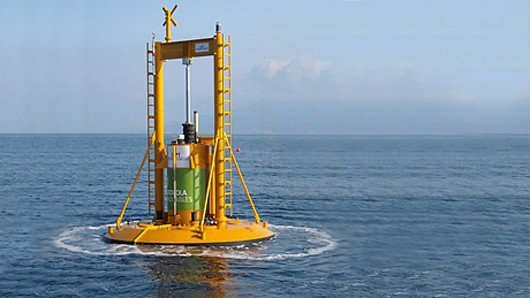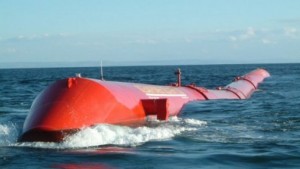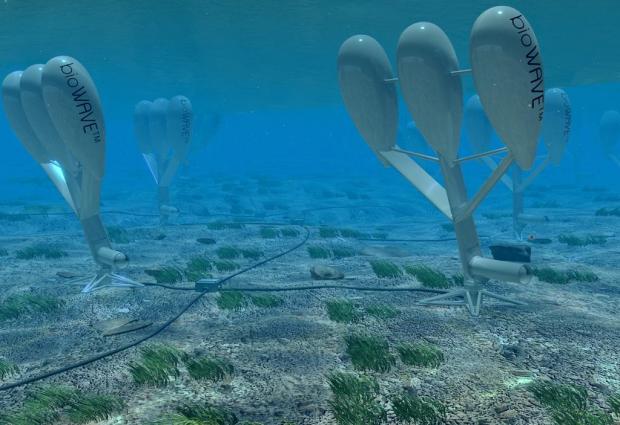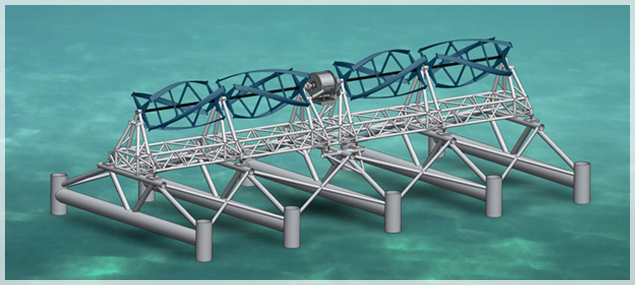In the last couple of months a number of wave energy technology projects have made the headlines. Wave-energy harnesses energy from ocean waves and converts it to electricity. Why consider wave power over wind or solar? Look at a world globe. It’s hard not to notice all the water which covers 70% of the planet. Harvesting just 0.2% of the kinetic energy of the waves and tides in our oceans would give us enough power to run the planet at current consumption rates.
Wave energy converts the energy the ocean receives from the Sun. As the Sun heats ocean water the water begins to move. At the same time the Sun heats the atmosphere above the ocean causing the air to move. Winds also set the ocean in motion. In addition the Earth’s rotation on its axis causes the water in the ocean to move. And finally the Earth, Moon and Sun’s gravitational interaction create tides.
Some may ask why not just use solar and wind power and not develop wave technology? There are many good reasons why waves and tides are good renewable energy options. These include:
- Waves are dense with energy compared to wind because water is more dense than air. A wave packs a lot of punch in a very small space when compared to wind.
- Waves operate when the Sun goes down where solar does not.
- Waves operate even when the wind dies down locally because swells can start thousands of kilometers away and continue for long distances.
- Tides operate based on gravitational pull of both the Moon and Sun and are predictable.
Wave-Energy Devices
Wave power works best where winds are most consistent. In the Northern and Southern Hemispheres the areas lie between 30 and 60 degrees latitude. In tropical regions waves are far less predictable. And in polar seas seasonal ice prohibits the use of wave technology.
Besides location the challenge for wave energy technology designers is to come up with devices that can operate on their own in corrosive saltwater conditions, handle variable wave size and direction, and require little in the way of maintenance.
To deal with variability, wave power researchers have designed on board sensors and predictive software capable of analyzing incoming waves and maximizing the operation of the wave generator to deal with the wave force. Work of this type is being done at the University of Exeter in the United Kingdom.
A number of device types have been developed including:
Terminators – buoy-styled devices such as the OPT PowerBuoy(R) feature pistons that move up and down in response to wave motion. The piston motion drives a turbine which generates electricity. Electricity is then transmitted onshore by subsurface cable. Some terminators use the motion of the wave to move a free-floating head up and down to drive a turbine. Others use a closed systems where the wave motion drives a piston attached to a pressurized cylinder filled with oil or a gas that in turn passes along the kinetic energy to a turbine. And some feature an open column, that allows water and air to enter and leave with the wave motion, causing pressure changes which then convert to kinetic energy to drive a turbine.

Attenuators – floating cylinder devices that lie parallel to a wave such as those created by Pelamis Wave Power. The floats are attached to a base on the sea bottom.The motion of the multi-segmented cylinders creates kinetic energy in the form of a pumping action that in turn drives on board generators. Electricity is transmitted to shore in the same way as in terminators.

Pivots – devices mounted on the sea bottom that feature buoyant floats that sway back and forth converting the motion to kinetic energy. The energy drives a pressurized hydraulic system which is attached to a generator. One device being deployed off the Australian coast is the bioWAVE(TM), a technology developed by BioPower Systems. Work will begin on deploying a single 250 Kilowatt device this year near Port Fairy, Victoria. The site chosen can accommodate up to 100 Megawatts of installed capacity.

Cycloids – are submerged turbines that use a propeller-like design with the propeller tips featuring a hydrofoil. As waves interact with the cycloid the hydrofoil tip capture the motion causing the device to rotate. Cycloids can operate at variable depths to capture waves and the energy from ocean currents. Atargis Energy Corporation is a pioneer in the development of cycloid wave energy devices. It calls its device the Cycloidal Wave Energy converter (CycWEC).

Tidal – designed to generate electricity in shallow tidal and deep river sites. Ocean Renewable Power Company is the developer of a turbine system called the TidGen(TM) Power System. Each device uses rotating foils to power a generator that is connected directly to an on-shore substation. Each TidGen generates up to 150 Kilowatts in water traveling at 11 kilometers per hour (6.6 miles). One of its systems will be the first tidal energy project in the United States. The final installation will include 20 underwater turbines producing electricity to power 1,200 homes.

















Did you know that Romania has a technical solution with the highest efficiency to capture wave power? Patent 108893 entitled Dynamic Engine for Sea Wave Energy Catching. A pioneering invention. It is estimated that “dynamic engine” has the ability to catching wave energy at a rate of over 80% while the other technical solutions known worldwide, are not able to capture wave energy with a higher percentage of about 10-15%. E-mail cosma.vasile@yahoo.com Cosma Vasile. Romania.
Code access for patent “Dynamic Engine”: PDF. 28723051. RO 108893 b1
There are a number of wave energy technologies going through testing presently. These include projects in the North Sea, off the coast of Maine in the North Atlantic, off the coast of Western Australia, and others. If the Romanian patented technology has made it out of the lab, where will it be field tested to demonstrate its efficiency and durability?